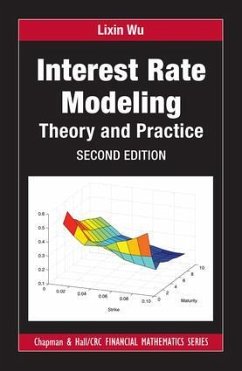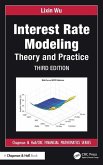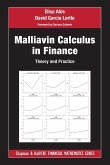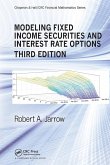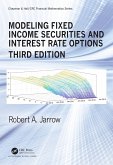- Gebundenes Buch
- Merkliste
- Auf die Merkliste
- Bewerten Bewerten
- Teilen
- Produkt teilen
- Produkterinnerung
- Produkterinnerung
Containing many results that are new or exist only in recent research articles, Interest Rate Modeling: Theory and Practice portrays the theory of interest rate modeling as a three-dimensional object of finance, mathematics, and computation.
Andere Kunden interessierten sich auch für
![Interest Rate Modeling Interest Rate Modeling]() Lixin WuInterest Rate Modeling86,99 €
Lixin WuInterest Rate Modeling86,99 €![Financial Mathematics Financial Mathematics]() Giuseppe CampolietiFinancial Mathematics61,99 €
Giuseppe CampolietiFinancial Mathematics61,99 €![Malliavin Calculus in Finance Malliavin Calculus in Finance]() Elisa AlosMalliavin Calculus in Finance50,99 €
Elisa AlosMalliavin Calculus in Finance50,99 €![Malliavin Calculus in Finance Malliavin Calculus in Finance]() Elisa AlosMalliavin Calculus in Finance111,99 €
Elisa AlosMalliavin Calculus in Finance111,99 €![Modeling Fixed Income Securities and Interest Rate Options Modeling Fixed Income Securities and Interest Rate Options]() Robert JarrowModeling Fixed Income Securities and Interest Rate Options50,99 €
Robert JarrowModeling Fixed Income Securities and Interest Rate Options50,99 €![Modeling Fixed Income Securities and Interest Rate Options Modeling Fixed Income Securities and Interest Rate Options]() Robert JarrowModeling Fixed Income Securities and Interest Rate Options115,99 €
Robert JarrowModeling Fixed Income Securities and Interest Rate Options115,99 €![Financial Mathematics Financial Mathematics]() Giuseppe CampolietiFinancial Mathematics98,99 €
Giuseppe CampolietiFinancial Mathematics98,99 €-
-
-
Containing many results that are new or exist only in recent research articles, Interest Rate Modeling: Theory and Practice portrays the theory of interest rate modeling as a three-dimensional object of finance, mathematics, and computation.
Produktdetails
- Produktdetails
- Chapman and Hall/CRC Financial Mathematics Series
- Verlag: Taylor & Francis Inc
- 2 ed
- Seitenzahl: 494
- Erscheinungstermin: 25. Februar 2019
- Englisch
- Abmessung: 241mm x 170mm x 35mm
- Gewicht: 928g
- ISBN-13: 9780815378914
- ISBN-10: 0815378912
- Artikelnr.: 54470188
- Herstellerkennzeichnung
- Libri GmbH
- Europaallee 1
- 36244 Bad Hersfeld
- gpsr@libri.de
- Chapman and Hall/CRC Financial Mathematics Series
- Verlag: Taylor & Francis Inc
- 2 ed
- Seitenzahl: 494
- Erscheinungstermin: 25. Februar 2019
- Englisch
- Abmessung: 241mm x 170mm x 35mm
- Gewicht: 928g
- ISBN-13: 9780815378914
- ISBN-10: 0815378912
- Artikelnr.: 54470188
- Herstellerkennzeichnung
- Libri GmbH
- Europaallee 1
- 36244 Bad Hersfeld
- gpsr@libri.de
Lixin Wu is a professor at the Hong Kong University of Science and Technology. Best known in the financial engineering community for his work on market models, Dr. Wu co-developed the PDE model for soft barrier options and the finite-state Markov model for credit contagion.
1. The Basics of Stochastic Calculus
2. The Martingale Representation Theorem
3. Interest Rates and Bonds
4. The Heath-Jarrow-Morton Model
5. Short-Rate Models and Lattice Implementation
6. The LIBOR Market Model
7. Calibration of LIBOR Market Model
8. Volatility and Correlation Adjustments
9. Affine Term Structure Models
10. The Market Model for Inflation-Rate Derivatives.
11. Levy Market Model
12. Market Model for Inflation Derivatives Modeling
13. Market Model for Credit Derivatives
14. Dual-Curve Market Models for Post-Crisis Interest Rate Derivatives
Markets
15. xVA Definition, Evaluation and Risk Management
2. The Martingale Representation Theorem
3. Interest Rates and Bonds
4. The Heath-Jarrow-Morton Model
5. Short-Rate Models and Lattice Implementation
6. The LIBOR Market Model
7. Calibration of LIBOR Market Model
8. Volatility and Correlation Adjustments
9. Affine Term Structure Models
10. The Market Model for Inflation-Rate Derivatives.
11. Levy Market Model
12. Market Model for Inflation Derivatives Modeling
13. Market Model for Credit Derivatives
14. Dual-Curve Market Models for Post-Crisis Interest Rate Derivatives
Markets
15. xVA Definition, Evaluation and Risk Management
1. The Basics of Stochastic Calculus. 1.1. Brownian Motions. 1.2. Stochastic Integrals. 1.3. Stochastic Differentials and Ito's Lemma. 1.4. Multi-Factor Extensions. 1.5. Martingales. 1.6. Feynman-Kac Theorem. 2. The Martingale Representation Theorem. 2.1. Changing Measures with Binomial Models. 2.2. Change of Measures under Brownian Filtration. 2.3. The Martingale Representation Theorem. 2.4. A Complete Market with Two Securities. 2.5. Replicating and Pricing of Contingent Claims. 2.6. Multi-Factor Extensions. 2.7. A Complete Market with Multiple Securities. 2.8. Notes. 3. U.S. Fixed-Income Markets. 3.1. The U.S. Federal Fund Market. 3.2. The U.S. Bond Markets. 3.3. Bond Mathematics. 3.4. Discount Curve and Zero-Coupon Yields. 3.5. Yield-Based Bond Risk Management. 3.6. The Interbank Lending Market. 3.7. The LIBOR Market. 3.8. Repurchasing Agreement. 4. LIBOR Transition and SOFR Derivatives Markets. 4.1. LIBOR Scandal and the Cessation of LIBOR. 4.2. SOFR. 4.3. Transition to Risk-Free Overnight Rates and LIBOR Fallbacks. 4.4. Linear Derivatives Based on the Risk-Free Rates. 4.5. Nonlinear Derivatives Based on the Risk-Free Rates. 5. Forward Measures and the Black Formula. 5.1. Lognormal Model: The Starting Point. 5.2. Forward Prices. 5.3. Forward Measure. 5.4. Black's Formula for Call and Put Options. 5.5. Numeraires and Change of Measures. 5.6. Futures Price and Futures Rate. 6. The Heath-Jarrow-Morton Model. 6.1. The HJM Model. 6.2. Estimating the HJM Model from Yield Data. 6.3. An Example of a Two-Factor Model. 6.4. Monte Carlo Implementations. 6.5. Special Cases of the HJM Model. 6.6. Linear Gaussian Models. 6.7. Pricing SOFR Derivatives under HJM Model. 6.8. Notes. 7. Short-Rate Models and Lattice Implementation. 7.1. From Short-Rate Models to Forward-Rate Models. 7.2. General Markovian Models. 7.3. Binomial Trees of Interest Rates. 7.4. A General Tree-Building Procedure. 8. Affine Term Structure Models. 8.1. An Exposition with One-Factor Models. 8.2. Analytical Solution of Riccarti Equations. 8.3. Pricing Options on Coupon Bonds. 8.4. Distributional Properties of Square-Root Processes. 8.5. Multi-Factor Models. 8.6. Pricing SOFR Futures under ATSMs. 8.7. Swaption Pricing under ATSMs. 8.8. Notes. 9. Market Model for SOFR Derivatives. 9.1. Market Model with SOFR Forward Term Rates. 9.2. Construction of the Initial Forward Rate Curve. 9.3. Monte Carlo Simulation Method. 9.4. Volatility Smiles and the Direct Adaptation of Smile Models. 10. Convexity Adjustments. 10.1. Pricing through Adjustments. 10.2. Quanto Derivatives. 11. Market Models with Stochastic Volatilities. 11.1. SABR Model. 11.2. Wu and Zhang Model. 11.3. Appendix: Derivation of the HKLW Formula. 11.4. Appendix: Proof of Proposition. 12. Lévy Market Model. 12.1. Introduction to Lévy Processes. 12.2. Lévy-HJM Model. 12.3. Market Model under Lévy Processes. 13. Market Model for Inflation Derivatives. 13.1. CPI Index and Inflation Derivatives Market. 13.2. Rebuilt Market Model and the New Paradigm. 13.3. Pricing Inflation Derivatives. 13.4. Model Calibration. 13.5. Smile Modeling. 14. Market Model for Credit Derivatives. 14.1. Pricing of Risky Bonds: A New Perspective. 14.2. Forward Spreads. 14.3. Two Kinds of Default Protection Swaps. 14.4. Par CDS Rates. 14.5. Implied Survival Curve and Recovery-Rate Curve. 14.6. Black's Formula for Credit Default Swaptions. 14.7. Market Model with Forward Hazard Rates. 14.8. Pricing of CDO Tranches under the Market Model. 14.9. Notes. 15. xVA: Definition, Evaluation, and Risk Management. 15.1. Pricing through Bilateral Replications. 15.2. The Rise of Other xVA. 15.3. Examples. 15.4. Notes.
1. The Basics of Stochastic Calculus
2. The Martingale Representation Theorem
3. Interest Rates and Bonds
4. The Heath-Jarrow-Morton Model
5. Short-Rate Models and Lattice Implementation
6. The LIBOR Market Model
7. Calibration of LIBOR Market Model
8. Volatility and Correlation Adjustments
9. Affine Term Structure Models
10. The Market Model for Inflation-Rate Derivatives.
11. Levy Market Model
12. Market Model for Inflation Derivatives Modeling
13. Market Model for Credit Derivatives
14. Dual-Curve Market Models for Post-Crisis Interest Rate Derivatives
Markets
15. xVA Definition, Evaluation and Risk Management
2. The Martingale Representation Theorem
3. Interest Rates and Bonds
4. The Heath-Jarrow-Morton Model
5. Short-Rate Models and Lattice Implementation
6. The LIBOR Market Model
7. Calibration of LIBOR Market Model
8. Volatility and Correlation Adjustments
9. Affine Term Structure Models
10. The Market Model for Inflation-Rate Derivatives.
11. Levy Market Model
12. Market Model for Inflation Derivatives Modeling
13. Market Model for Credit Derivatives
14. Dual-Curve Market Models for Post-Crisis Interest Rate Derivatives
Markets
15. xVA Definition, Evaluation and Risk Management
1. The Basics of Stochastic Calculus. 1.1. Brownian Motions. 1.2. Stochastic Integrals. 1.3. Stochastic Differentials and Ito's Lemma. 1.4. Multi-Factor Extensions. 1.5. Martingales. 1.6. Feynman-Kac Theorem. 2. The Martingale Representation Theorem. 2.1. Changing Measures with Binomial Models. 2.2. Change of Measures under Brownian Filtration. 2.3. The Martingale Representation Theorem. 2.4. A Complete Market with Two Securities. 2.5. Replicating and Pricing of Contingent Claims. 2.6. Multi-Factor Extensions. 2.7. A Complete Market with Multiple Securities. 2.8. Notes. 3. U.S. Fixed-Income Markets. 3.1. The U.S. Federal Fund Market. 3.2. The U.S. Bond Markets. 3.3. Bond Mathematics. 3.4. Discount Curve and Zero-Coupon Yields. 3.5. Yield-Based Bond Risk Management. 3.6. The Interbank Lending Market. 3.7. The LIBOR Market. 3.8. Repurchasing Agreement. 4. LIBOR Transition and SOFR Derivatives Markets. 4.1. LIBOR Scandal and the Cessation of LIBOR. 4.2. SOFR. 4.3. Transition to Risk-Free Overnight Rates and LIBOR Fallbacks. 4.4. Linear Derivatives Based on the Risk-Free Rates. 4.5. Nonlinear Derivatives Based on the Risk-Free Rates. 5. Forward Measures and the Black Formula. 5.1. Lognormal Model: The Starting Point. 5.2. Forward Prices. 5.3. Forward Measure. 5.4. Black's Formula for Call and Put Options. 5.5. Numeraires and Change of Measures. 5.6. Futures Price and Futures Rate. 6. The Heath-Jarrow-Morton Model. 6.1. The HJM Model. 6.2. Estimating the HJM Model from Yield Data. 6.3. An Example of a Two-Factor Model. 6.4. Monte Carlo Implementations. 6.5. Special Cases of the HJM Model. 6.6. Linear Gaussian Models. 6.7. Pricing SOFR Derivatives under HJM Model. 6.8. Notes. 7. Short-Rate Models and Lattice Implementation. 7.1. From Short-Rate Models to Forward-Rate Models. 7.2. General Markovian Models. 7.3. Binomial Trees of Interest Rates. 7.4. A General Tree-Building Procedure. 8. Affine Term Structure Models. 8.1. An Exposition with One-Factor Models. 8.2. Analytical Solution of Riccarti Equations. 8.3. Pricing Options on Coupon Bonds. 8.4. Distributional Properties of Square-Root Processes. 8.5. Multi-Factor Models. 8.6. Pricing SOFR Futures under ATSMs. 8.7. Swaption Pricing under ATSMs. 8.8. Notes. 9. Market Model for SOFR Derivatives. 9.1. Market Model with SOFR Forward Term Rates. 9.2. Construction of the Initial Forward Rate Curve. 9.3. Monte Carlo Simulation Method. 9.4. Volatility Smiles and the Direct Adaptation of Smile Models. 10. Convexity Adjustments. 10.1. Pricing through Adjustments. 10.2. Quanto Derivatives. 11. Market Models with Stochastic Volatilities. 11.1. SABR Model. 11.2. Wu and Zhang Model. 11.3. Appendix: Derivation of the HKLW Formula. 11.4. Appendix: Proof of Proposition. 12. Lévy Market Model. 12.1. Introduction to Lévy Processes. 12.2. Lévy-HJM Model. 12.3. Market Model under Lévy Processes. 13. Market Model for Inflation Derivatives. 13.1. CPI Index and Inflation Derivatives Market. 13.2. Rebuilt Market Model and the New Paradigm. 13.3. Pricing Inflation Derivatives. 13.4. Model Calibration. 13.5. Smile Modeling. 14. Market Model for Credit Derivatives. 14.1. Pricing of Risky Bonds: A New Perspective. 14.2. Forward Spreads. 14.3. Two Kinds of Default Protection Swaps. 14.4. Par CDS Rates. 14.5. Implied Survival Curve and Recovery-Rate Curve. 14.6. Black's Formula for Credit Default Swaptions. 14.7. Market Model with Forward Hazard Rates. 14.8. Pricing of CDO Tranches under the Market Model. 14.9. Notes. 15. xVA: Definition, Evaluation, and Risk Management. 15.1. Pricing through Bilateral Replications. 15.2. The Rise of Other xVA. 15.3. Examples. 15.4. Notes.
"A part of the Chapman & Hall/CRC Financial Mathematics series, Professor Lixin Wu's "Interest Rate Modeling: Theory and Practice, third edition" is a premier and solidly recommended acquisitions choice for corporate and college/university library Economics/Mathematics collections and as a supplemental Economics curriculum textbook."
-Midwest Book Review
-Midwest Book Review

